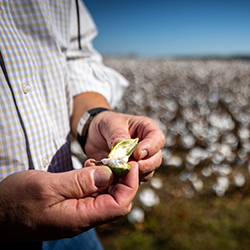This post is part of our blog series entitled “The Journey of Cotton.” This series will focus on the seven unique steps that it takes to process cotton, starting with the planting of the crop to the point it becomes a specific consumer product. We previously discussed harvesting cotton, but today’s post will focus on the third step in that journey: ginning the cotton.
First, the Cotton’s Moisture Must Be Measured
In cotton ginning, the main goal is to separate the seed and lint from the cotton fiber. The freshly picked cotton arrives at the gin with the seeds still in the fiber, as well as sticks, stems, burrs, and other unwanted visible foreign matter. In the first stage of the ginning process, the moisture of the cotton is measured, which determines the amount of heat that will be applied to open the fiber. Air is used to mix the heat with the seed cotton as it passes through the first stage of cleaning called an incline cleaner. Any large sticks and burrs are removed and sent to a waste pile; later, they will be spread back onto the same fields to become composite. Here’s a video that we found to be extremely helpful in portraying the ginning process:
Next, It’s Time to Separate the Seed from the Fiber
The cleaned seed cotton is then conveyered over gin feeders, where additional cleaning takes place. At this point the cotton drops into the cotton gin stand. Here the seed is removed from the lint by saw blades that pull the lint away as the seed hits spacers (ribs) that do not let the seed pass through. Next, the seed drops into an auger and will later either be crushed for cotton seed oil or fed to dairy cattle to aid in the production of milk.
Lastly, Cotton Is Pressed into Bales and Tested
 The lint removed at the gin stand will go through finer cleaners where smaller sized foreign material is removed. Once the cotton is cleaned, it is hydraulically pressed into 500-pound blocks called bales. Every bale of ginned cotton in the U.S. goes through a standardized process of measurement and classification conducted by the USDA before it can be traded (bought or sold) to manufacturers (yarn spinners, purifiers, nonwoven manufacturers, textile mills, etc). Each 500-pound bale of ginned cotton has a sample taken from it, which is tested for key characteristics such as: fiber length (or staple), strength, micronaire (or fineness), color, uniformity, and leaf content. The results of this testing determines the cotton’s ultimate value and optimal use in manufacturing. We will dive deeper into the classification of cotton and how it affects the fiber’s price and application in a future blogs series.
The lint removed at the gin stand will go through finer cleaners where smaller sized foreign material is removed. Once the cotton is cleaned, it is hydraulically pressed into 500-pound blocks called bales. Every bale of ginned cotton in the U.S. goes through a standardized process of measurement and classification conducted by the USDA before it can be traded (bought or sold) to manufacturers (yarn spinners, purifiers, nonwoven manufacturers, textile mills, etc). Each 500-pound bale of ginned cotton has a sample taken from it, which is tested for key characteristics such as: fiber length (or staple), strength, micronaire (or fineness), color, uniformity, and leaf content. The results of this testing determines the cotton’s ultimate value and optimal use in manufacturing. We will dive deeper into the classification of cotton and how it affects the fiber’s price and application in a future blogs series.
Up Next: Cotton Purification
This is part four of our seven-part Journey of Cotton series. (If you missed our Introduction, be sure to visit that blog post.) The next step in the cotton journey is Purification, so keep an eye out on our blog for updates. You can also enter your email address in the “Stay in the Know” field in the right margin to have blog updates sent directly to your inbox.
